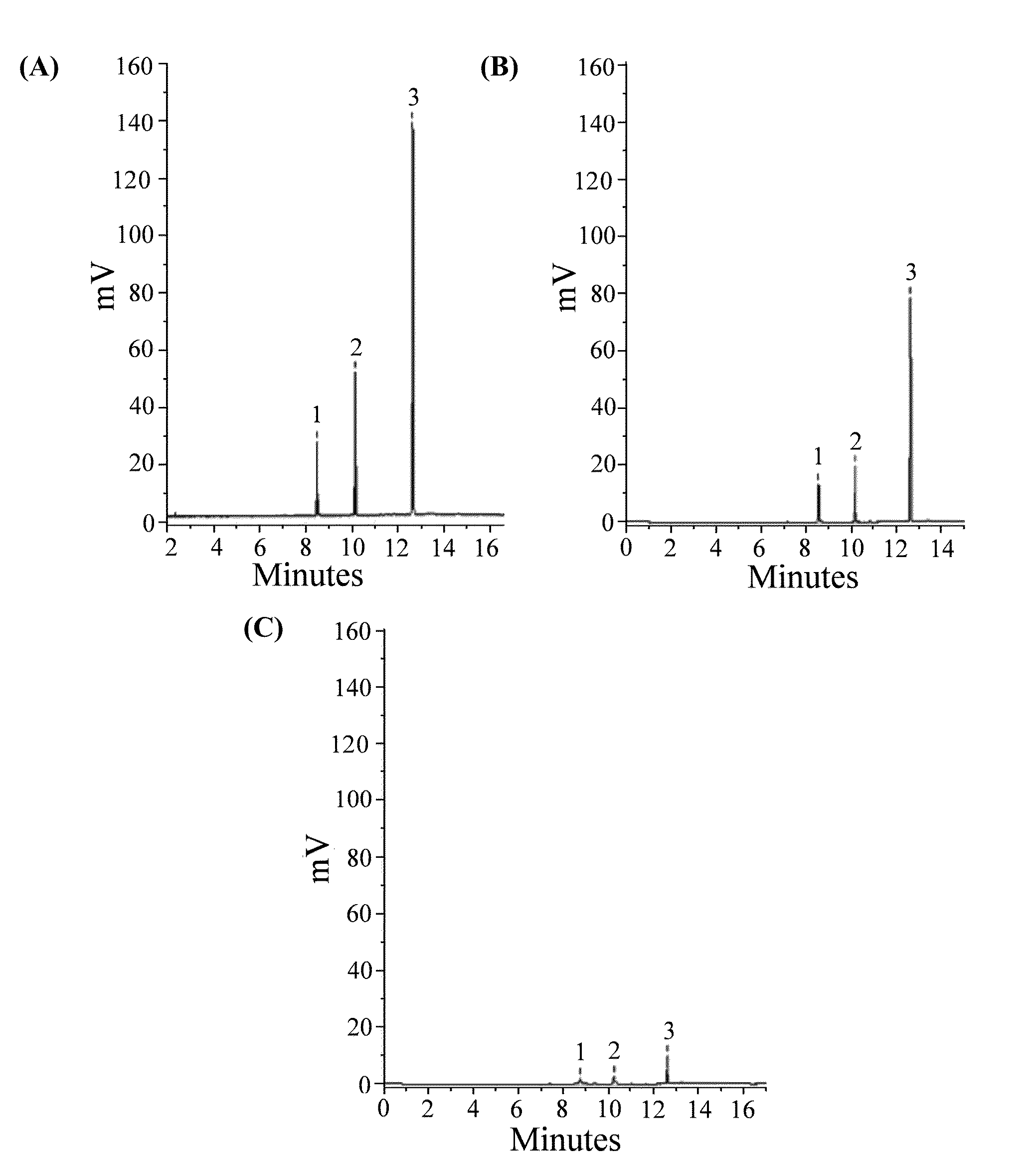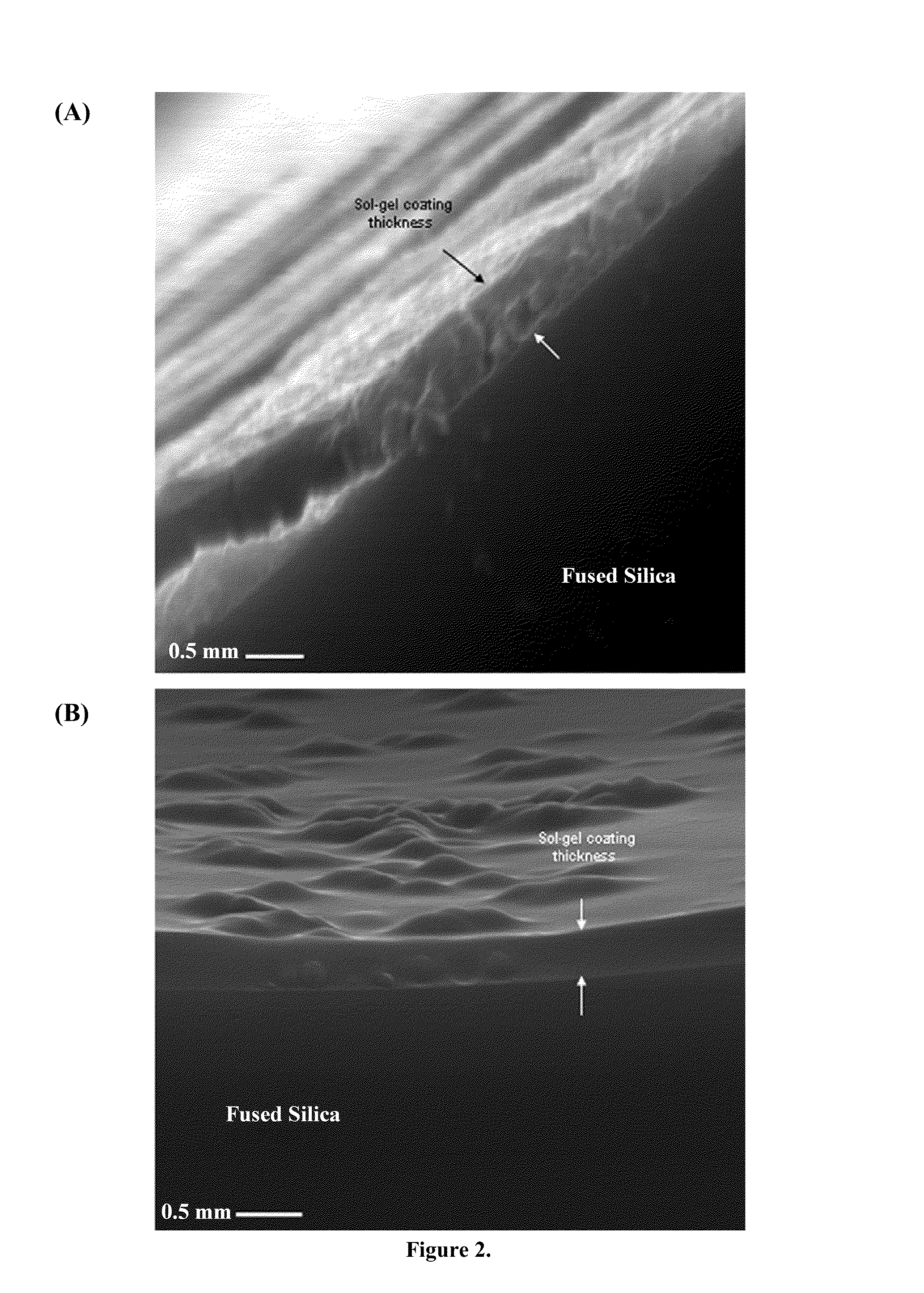Method of making ionic liquid mediated sol-gel sorbents
a technology of sol-gel and ionic liquid, which is applied in the field of creating ionic liquid sorbents, can solve the problems of increasing the time required to form sol-gel, lowering the hydrolysis rate, etc., and achieves the effect of starting hydrolysis and/or polymerization
- Summary
- Abstract
- Description
- Claims
- Application Information
AI Technical Summary
Benefits of technology
Problems solved by technology
Method used
Image
Examples
example 1
[0045]PDMS, BMPO, or polyTHF was individually weighed into a clean microcentrifuge tube in the amount shown in Table 2. In all cases, a mixture of 250 μL of methylene chloride and 50 μL of ionic liquid, TTPT or MOIC, was added.
[0046]Next, TEOS (50 μL) and PMHS (10 μL) were added in sequence for PDMS. In the case of poly-THF, PDMDSP, and BMPO sol-gels no PMHS was added, as seen in Tables 2 and 3. This was followed by the addition of 504, TFA 99%. After the addition of each chemical ingredient, the solution was vortexed for 1 min to ensure thorough mixing. The sol solution was further centrifuged for 4 min at 14,000 rpm (18,297×g). The supernatant was decanted into a clean microcentrifuge tube. Sol gels without ionic liquid (PDMS-no IL, polyTHF-no IL, PDMDPS-no IL, and BMPO-no IL) were prepared in a similar manner except that 300 μL of CH2C12 was used as solvent instead of a mixture of CH2Cl2 (250 μL) and TTPT (50 μL). An ionic liquid-mediated PEG sol-gel (PEG-IL) and a PEG sol-gel th...
example 2
Ionic Liquid (TTPT)-Mediated Polar Sol-Gel Microextraction Capillaries: PEG, PolyTHF, And BMPO
[0050]The supernatant of the centrifuged sol solution produced in Example 1 was immediately utilized to coat the capillaries. For each sol-gel composition, a hydrothermally treated (Hayes, PhD Dissertation, University of South Florida, Tampa, Fla., 2000) fused-silica capillary (50 cm×250 μm i.d.) was installed on a home-built filling / purging device (Hayes & Malik, J. Chromatogr. B 695 (1997) 3). The capillary was filled with the sol solution using helium (20 psi; 1.38×105 Pa) until full. After several drops of the coating sol solution dripped out of the capillary, its exit end was sealed with a rubber septum. The solution was allowed to reside inside the capillary for 20 min to facilitate the formation of a surface-bonded sol-gel coating. After this in-capillary residence period, the rubber septum was removed from the capillary end and the un-bonded bulk sol solution was expelled from the c...
example 3
Extraction Profiles and Characteristics of Ionic Liquid (TTPT)-Mediated Sol-Gel Microextraction Capillaries: PEG, PolyTHF, and BMPO
[0055]Capillaries produced as described in Example 2 were analyzed. A CME-GC analysis was conduced with aqueous samples, which were prepared using compounds from various chemical classes (aliphatic alcohols, aliphatic aldehydes, aromatic ketones, and polycyclic aromatic hydrocarbons [PAHs]). For each analyte, a stock solution (10 mg / mL) was prepared in methanol and was stored in a surface deactivated 6 mL glass scintillation vial. Fresh aqueous samples were prepared prior to extraction by further diluting these stock solutions with DI water to ng / mL levels. CME was performed as previously described (Bigham, et al., Anal. Chem. 74 (2002) 752). Briefly, an 11-cm long sol-gel coated microextraction capillary was vertically connected to the bottom of the empty gravity-fed sample dispenser (Bigham, et al., Anal. Chem. 74 (2002) 752). Liquid sample (15 mL) wa...
PUM
| Property | Measurement | Unit |
|---|---|---|
| temperature | aaaaa | aaaaa |
| temperature | aaaaa | aaaaa |
| temperature | aaaaa | aaaaa |
Abstract
Description
Claims
Application Information
 Login to View More
Login to View More - R&D
- Intellectual Property
- Life Sciences
- Materials
- Tech Scout
- Unparalleled Data Quality
- Higher Quality Content
- 60% Fewer Hallucinations
Browse by: Latest US Patents, China's latest patents, Technical Efficacy Thesaurus, Application Domain, Technology Topic, Popular Technical Reports.
© 2025 PatSnap. All rights reserved.Legal|Privacy policy|Modern Slavery Act Transparency Statement|Sitemap|About US| Contact US: help@patsnap.com



